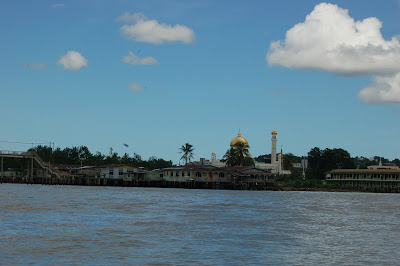Today, a very long stopover has allowed me to explore a small piece of Asia for the first time. Brunei is a small country which shares the island of Borneo with Malaysia and Indonesia. In fact it previously owned the whole island, but gave away part of the land to its neighbours.
Today Brunei, or Negara Brunei Darassalam to give it its full name, is the last Malay Sultanate, and one of three monarchies ruled by dynasties claiming descent from Prophet Mohammad. Unsurprisingly, the country is 80% Muslim, though claims tolerance of other faiths. English is the second language and widely spoken. Its proud history is evident in some of the most beautiful mosques in South-East Asia. The country has rich sources of oil and natural gas, the residents pay no income tax, the crime rate is very low, and money collected for the poor went undistributed for years because they simply couldn’t find any poor to give it to.
Having it's own oil supply and no taxes, means that fuel prices in Brunei are low (1$ is worth less than 1€!)
The literal translation of the country’s name means Abode of Peace, and the residents definitely seem happy and proud of their country. The government is stable, residence have one of the world’s highest per capita incomes, and a life expectancy of 75 years. Despite its location, Brunei is free from tropical diseases, lies outside the typhoon belt, is not prone to earthquakes and does not have volcanoes, but best of all it is not at all crowded. The 5,765-square kilometre kingdom, three-quarters of which is virgin rainforest, is home to less than a half a million people, and many of them live in the largest water village in the world in the country’s capital, Bandar Seri Begawan.
It is the capital and its surrounds, rather than the rainforest, which I had the opportunity to explore today, and here are some of the photos from my tour.
His Majesty Sultan Haji Hassanal Bolkiah is the 29th ruler of the world’s oldest continuously reigning dynasty. His official residence is the largest residential palace in the world. At 2000,000 square metres (compared with the 77,000 square metres of Buckingham Palace), it has 1,788 rooms, a 110-car garage, and a lot of gold!
Despite its size, however, it’s difficult to get a good view of the palace. This is the best shot that I managed.
The Royal Regalia Building is basically a museum to the Sultan and his Kingdom. There were numerous royal relics on display, presents he has received from foreign leaders, and chariots used in royal processions, including this one from the Coronation in 1968.
The Jame ‘Asr Hassanil Bolkiah Mosque is the largest in Brunei, and has 29 golden domes, one to represent each of the kingdom’s sultans. It is just one of a number of fine mosques in the small city.
It is obvious from the mosques and that palaces that this is a very wealthy country, and that they are not afraid to spend a few bob on a bit of gold here and there. The best demonstration of the country’s wealth, however, I feel is the fact that Queen Elizabeth II has her own house here. The large villa was built especially for her visit here in 1972, and today is unoccupied apart from the maid, chef, cleaner and gardener who maintain the property in wait for when she may decide to make a return visit.
Despite no longer being a fishing people, many of the city’s population still choose to live in the water village. On the city side of the river there is a large parking area full of cars. This is where the water village people park the cars which they use to travel to and from work. They live in the stilted houses out of choice rather than necessity. From the outside the water village looks something of a shanty town, but that is far from the case. The tour gave me the opportunity to see inside one of the houses, and inside it is very comfortable indeed. All houses have running water and electricity, and many have satellite dishes too. This is far from a shanty town.
From what I’ve seen Brunei is a beautiful country; probably one of Asia’s best kept secrets. Next time I’ll hopefully get to do some monkey spotting. I hear they’ve got some orangutans around here!















